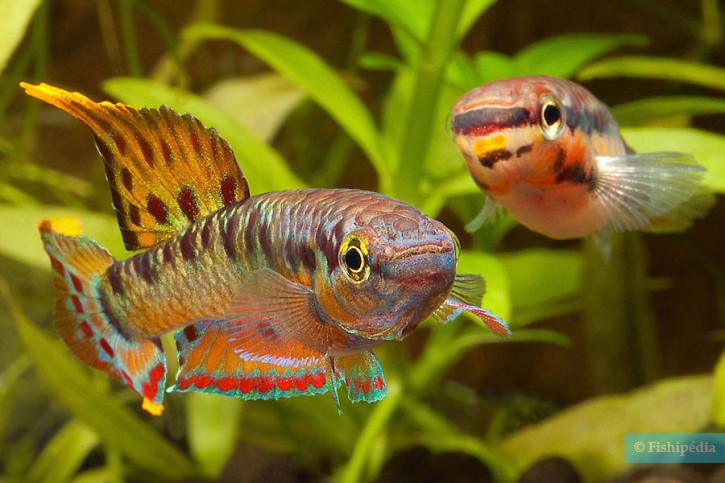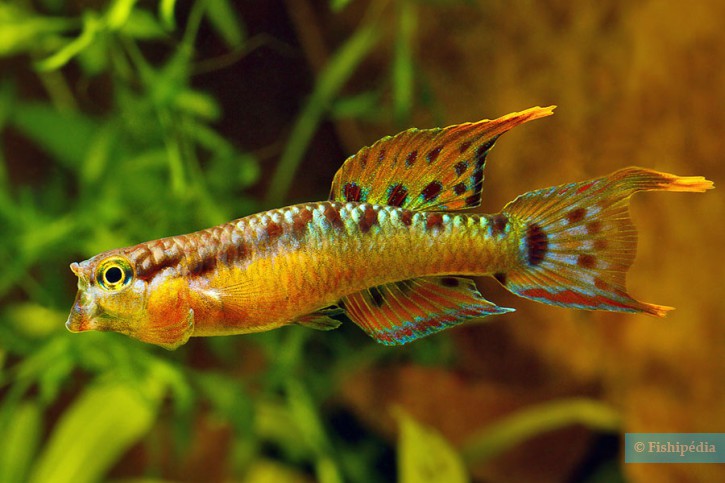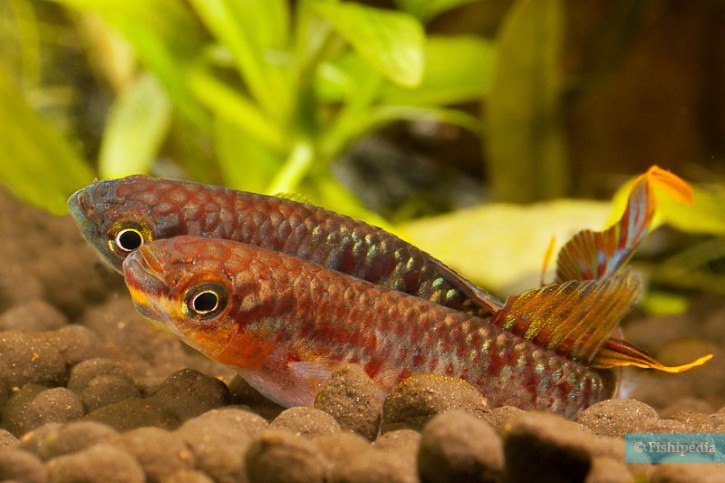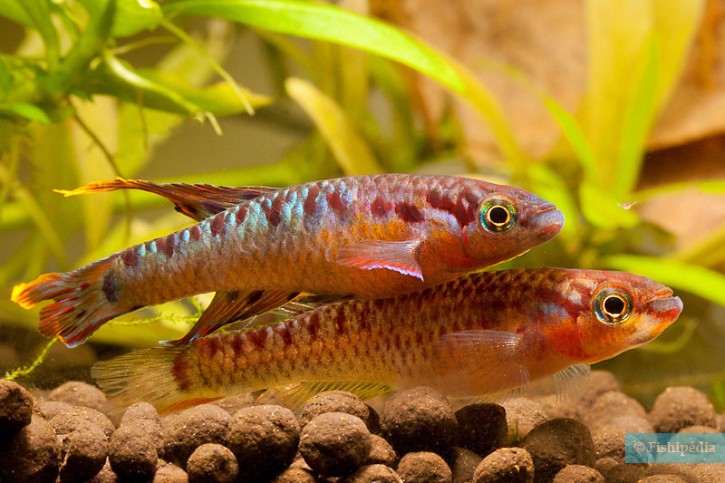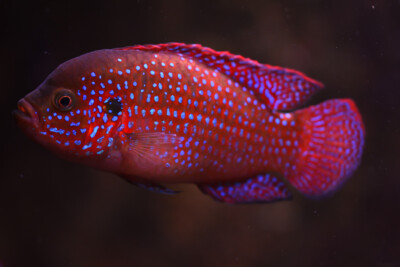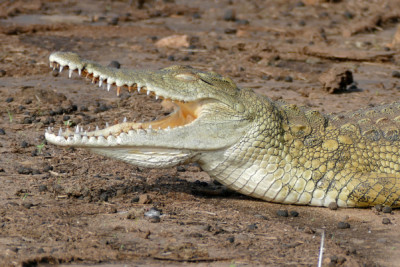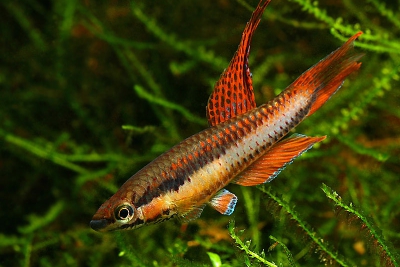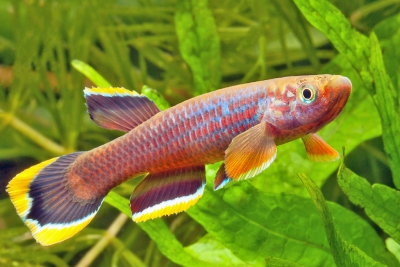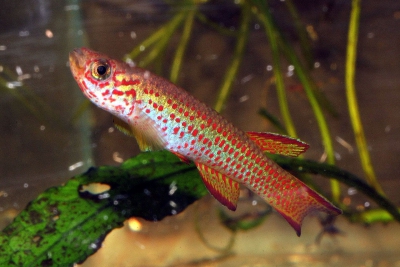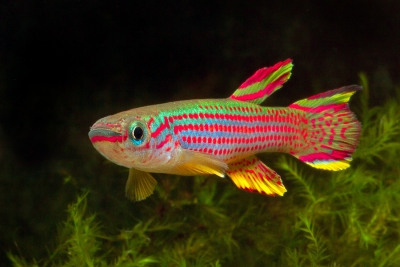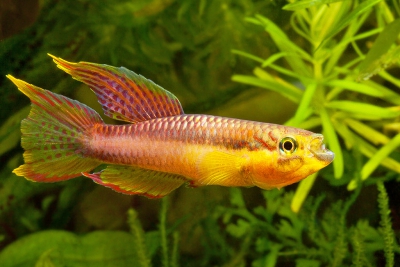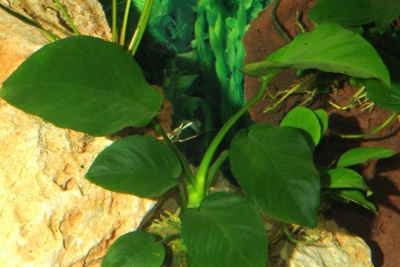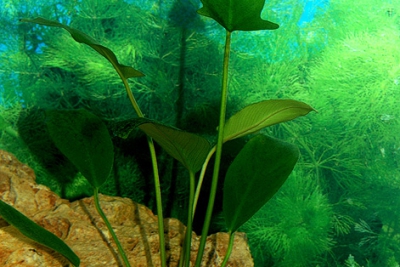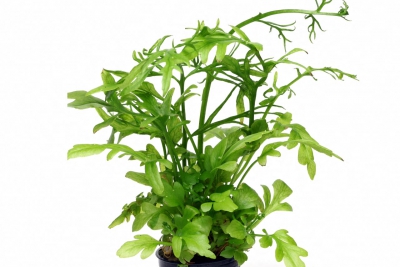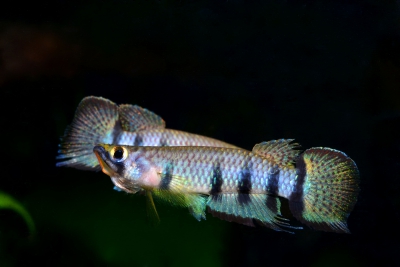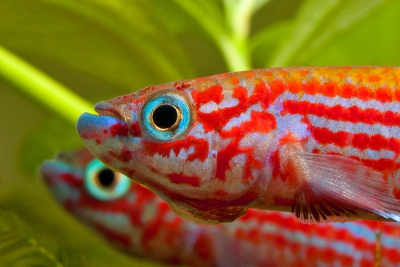twostripe lyretail
| Scientific name | Aphyosemion bivittatum |
|---|---|
| Descriptor | Lönnberg |
| Year of description | 1895 |
| IUCN category (World) | LC |
| Family | Nothobranchiidae |
| Genus | Aphyosemion |
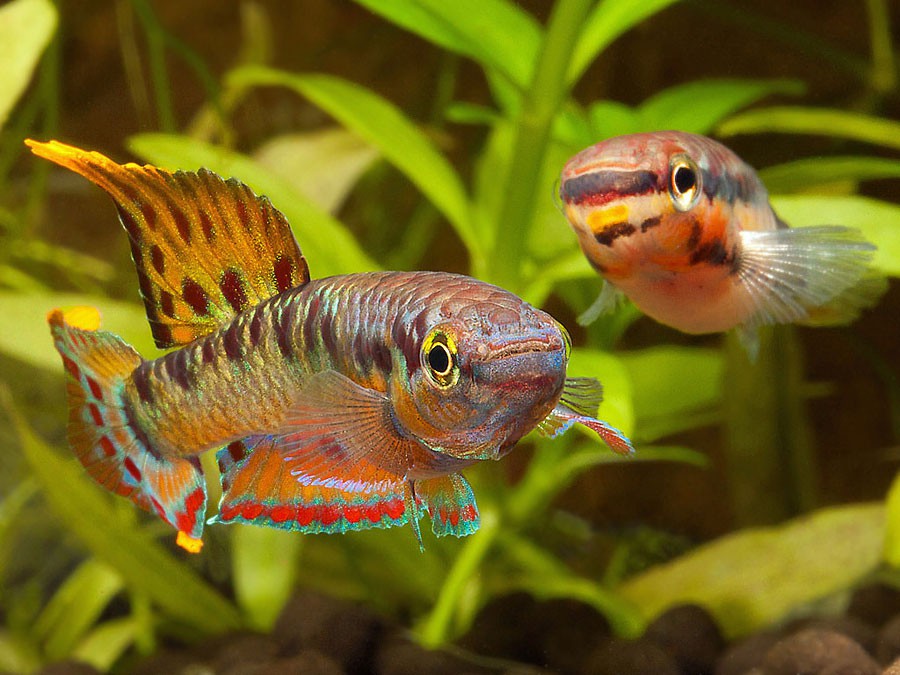

Introduction
Aphyosemion bivittatum, more commonly known as the twostripe lyretail, is a small tropical freshwater fish endemic to Lower Guinea in Africa.
Who is it?
Morphology
-
Type
-
Average size4 cm
-
Maximum size5 cm
-
Type
-
Average size4 cm
-
Maximum size5 cm
How to recognize This fish ?
The male Aphyosemion bivittatum is robust and has extensions on all odd fins. The dorsal fin has 10-13 rays; the anal fin 12-15 rays. The position dorsal fin / anal fin = 1/2. There are 25-28 scales along the lateral line.
Coloration
Male: the body color is light brown with a beautiful blue sheen on the sides. On the anterior part of the body, there are dark red spots, forming horizontal lines. On the rear part of the body, mainly above the mid-lateral line, there are large dark red spots that can form short transverse bars. The throat is usually orange. The color of the dorsal fin varies, from blue in the Calabar and Ndian populations to light orange with a blue upper edge in the Funge population. Dark red spots are present between the rays of this fin and the extension is orange. The anal fin is blue-green with a light orange tint, and some dark red spots at the base and near the edge. Sometimes, they can form a marginal line. The caudal fin is blue to orange (depending on the populations) with dark red spots and stripes. On the upper and lower lobes of the fin, there is a series of dark red spots, which can form bands. The fin extensions are orange. Sometimes on the caudal peduncle, there are two large dark spots, which can merge into a vertical band. Young males have two dark longitudinal bands, which disappear with maturity.
Female: the body color is yellow-grey with two dark longitudinal bands. All fins are colorless, except for the dorsal fin which is pale light blue with darker spots.
However, there are several variations in shapes and colors depending on the origin of the individuals.
Sexual dimorphism
The male Aphyosemion bivittatum is more colorful and larger than the female.
Behaviour & Life cycle
-
dietcarnivorous
-
Sociabilityliving in small groups
-
territorialYes
-
Way of livingdiurnal
The Aphyosemion bivittatum is a fish living in small scattered groups. It naturally resides in vegetation. It is a species with a temperament rather calm.
Although territorial, the Aphyosemion bivittatum remains a rather peaceful fish that generally behaves peacefully with other species.
Reproduction
-
Reproductionovipare qui dépose ses Œufs dans la végétation
The Aphyosemion bivittatum is an oviparous fish that hides its adhesive eggs, with a diameter of about 1.3 mm, in vegetation. In an aquarium, egg incubation lasts about 3 weeks.
Harmless species
This species does not represent any particular threats to humans when encountered in its natural environment.
Origin and distribution
Geographic distribution & Conservation
This species is endemic to Lower Guinea (Nigeria and Cameroon). It frequents small streams and rivers on calcareous soil in the coastal rainforest of southeastern Nigeria and southwestern Cameroon, from the Lower Cross to the east of Mundemba, its eastern distribution limit.
Aphyosemion bivittatum is probably present in more than the five currently known locations, but certainly less than 10 sites. Deforestation due to the establishment of oil palm plantations, pollution, and the drying up of wetlands are the main threats to the species. Trade from the aquarium industry is potentially harmful to this species. Aphyosemion bivittatum has been listed as "vulnerable" by the IUCN.
Conservation status of populations (IUCN)
What is its habitat?
Natural environment characteristics
-
Temperature22 - 24 °C
-
pH (acidity)5.5 - 6.5
-
gh (hardness)1 - 3
-
FlowSlow
Biotope presentation
The Aphyosemion bivittatum naturally resides in slightly acidic water. The species evolves in shallow water (about 30 cm) in areas with a strong presence of vegetation (aquatic and swamp plants, decaying organic matter, branches...).
Species of the same biotope
Main recommendations for fishkeeping
Deontology
In order to preserve wildlife, if you acquire this animal, it must not be released into the wild. See also, the Fishipedia charter.
Fishipedia supports the practice of responsible and environmentally friendly aquarium keeping. We encourage maintenance if it is motivated by a desire to understand the biological functioning of living things and if it is done with respect for animal life.
We believe that aquaristics is an opening to the discovery of aquatic environments, especially freshwater, and that this knowledge is necessary to better protect and respect these environments. Logically, we refute the compulsive purchase of animals that would not find a sufficient and / or adapted place in the host aquarium.
Our recommendationsThese tips apply to adult species from breeding. With regards to water conditions, wild species or close relatives must be kept under the same conditions as in their area of origin.
-
Min volume20 liters
-
Population min2
-
Temperature22 - 24 °C
-
pH (acidity)5.5 - 6.5
CharacteristicsThe characteristics below apply for adult species. They correspond to an average of cases, validated in maintenance condition.
-
Difficulty breedingThe farming difficulty is relative. It depends on experiments already carried out with similar species. First, it takes into consideration the robustness of the species, the ease of recreation of a favorable environment and the general behaviour with the other inhabitants of the aquarium.moderate
-
Robustnesstolerant
-
Behaviourpeaceful
-
Availabilityoccasional
Recommended equipment from our partners
-
Aquarium
General reminders
It is strongly advised to read the complete dedicated file and to get information on the feedbacks of maintenance of the envisaged animal, this to avoid any potential conflict whose end result is generally the death of the individual (or the other inhabitants). It is important not to overload your aquarium to limit pollution. This will make maintenance easier.
In nature, animals are subject to weather conditions and live in waters with variable characteristics. The recommendations offered by our team for aquarium maintenance are a guidance and cannot be assimilated to scientific datas.
General reminder on maintenance datas
Le démarrage d'un aquarium est une partie primordiale pour l'équilibre et le bien-être des poissons. Lorsque l'on met en eau un aquarium, l'eau passe naturellement par un cycle biologique : le cycle de l'azote. Celui-ci dure environ trois semaines. Tous les 2 jours, nous vous conseillons de tester votre eau jusqu'à ce que le taux de nitrite soit à zéro pendant plusieurs jours d'affilée.
Pour accélérer ce cycle, vous pouvez utiliser un activateur de bactéries comme JBL Denitrol. Cette solution riche en bactéries vivantes et enzymes permet une mise en place rapide du cycle de l'azote. Les poissons peuvent alors être introduits plus rapidement.
Il est important de tester l'eau de son aquarium régulièrement pour maintenir un environnement sain pour les poissons et les autres habitants. Les tests d'eau permettent de mesurer les niveaux de différents paramètres tels que le pH, la dureté totale, ainsi que les taux de nitrates, de nitrites et d'ammoniaque.
Pour réaliser ces tests, vous pouvez utiliser des produits d'analyse spécialisés tels que JBL ProScan qui permet de réaliser un diagnostic de l'eau directement via un smartphone. Il existe également des coffrets de tests plus classiques de bandelettes, comme JBL PROAQUATEST.
En cas d’usage de l’eau du robinet, vous pouvez utiliser un conditionneur d’eau de type Biotopol de JBL pour éliminer les substances nocives comme le chlore, le cuivre, le plomb et le zinc. Les conditionneurs d'eau garantissent une meilleure santé aux poissons et une meilleure croissance des plantes.
Chlorine and chloramine are dangerous for the health of animals. Used to disinfect water, these agents are present in significant quantities in tap water. We recommend using an anti-chlorine agent every time you change the water. In addition to chlorine, treatments and medicines sold for aquarium use sometimes contain dangerous heavy metals in high doses.
Specific needs for the twostripe lyretail
The twostripe lyretail is a species which lives naturally at a temperature between 22 °C and 24 °C. For proper maintenance, the temperature should never exceed the 27°C for long periods. Nitrate levels should remain below 50mg/L. To keep the water clean and unpolluted, plan on changing 20% to 30% of the water volume each month.
The breeding of this species is accessible on condition of being well informed about its needs in aquarium . Any cohabitants must be chosen with care to avoid the loss of animals.
This species is generally available in specialized shops or from aquarium clubs. Specimens that have been bred for a long time are easier to breed, but special water parameters must be respected.
Jumping fish
Be careful, the twostripe lyretail is an excellent jumper, naturally using this faculty to change its living area or to escape from predators. The aquarium must be perfectly covered to prevent him from making a deadly jump...
Cohabitation & Environment
The twostripe lyretail is a fish which it is advisable to maintain in specific aquarium. Associating it with other species is not fundamentally impossible but a documentation work is necessary for the constitution of the population. Being a living in small groups fish, it is advisable to install at least 2 individuals in an aquarium of 20 liters minimum. Group maintenance is a prerequisite to ensure their well-being. Lonely individuals tend to quickly become stressed and become especially susceptible to disease.
It should be noticed that this species should not be kept with large crustaceans or fish, as it would become a prey of choice. Smaller species should preferably be inserted in the aquarium some time before the larger ones. Moreover, if you want to breed it, it is better to put them in a specific aquarium.Tips for feeding
The twostripe lyretail is carnivorous.
This species can eat dry food (flakes, pellets), fresh food and frozen food. To avoid deficiencies, it is recommended to vary the types of food.
You should not overfeed your residents to avoid polluting the water. For most species, it is better to feed a few small portions each day rather than one large meal.
Food recommendations from our partner JBL - Products PRONOVO
-
Granules
-
Flakes
-
Sticks
Reproduction protocol
-
Maintenance difficultymoderate
-
egg-laying protectionNo
Hybridization risks
In general, it is advised not to mix several species of the same genus or different varieties of the same species, to avoid the risks of hybridization.
These animals might interest you
These plants might interest you
Plants play a crucial role in aquariums, both for their ability to filter water by absorbing excess nutrients and for their aesthetic contribution. They provide fish with natural hiding places, can serve as breeding sites, and generally help maintain the overall balance and optimal conditions of the aquarium. The selection presented here includes species from the same regions as the species described on this page, although they do not necessarily come from its exact natural biotope.
To go further
Sources & Contributions
Participation & Validation
The Fishipedia team and specialist contributors are committed to providing high-quality content. However, although the information comes from scientific sources or testimonials from specialists, the cards may contain inaccuracies.

Benoit Chartrer

Didier Paugy
Translation
Translation done with the valuable contribution of our translators, who make this information available to a wider audience. We sincerely thank them for their commitment.
Scientific partners
Tags
Species of the same family
Same genus
Species of the same biotope
